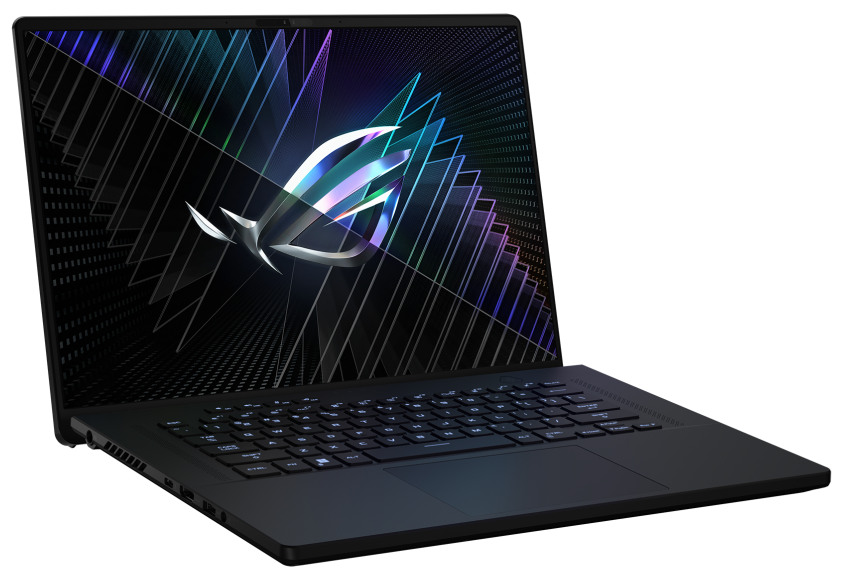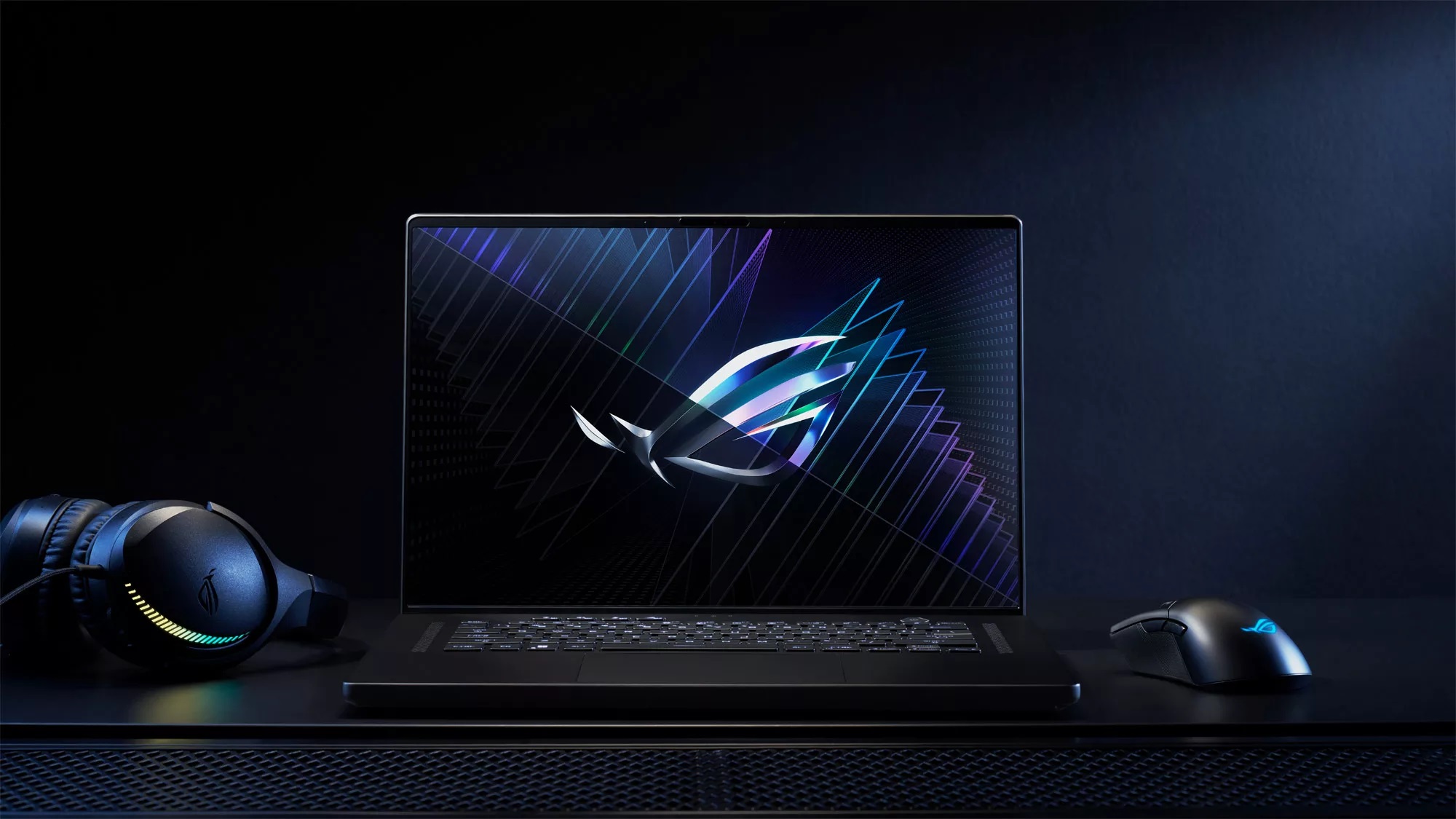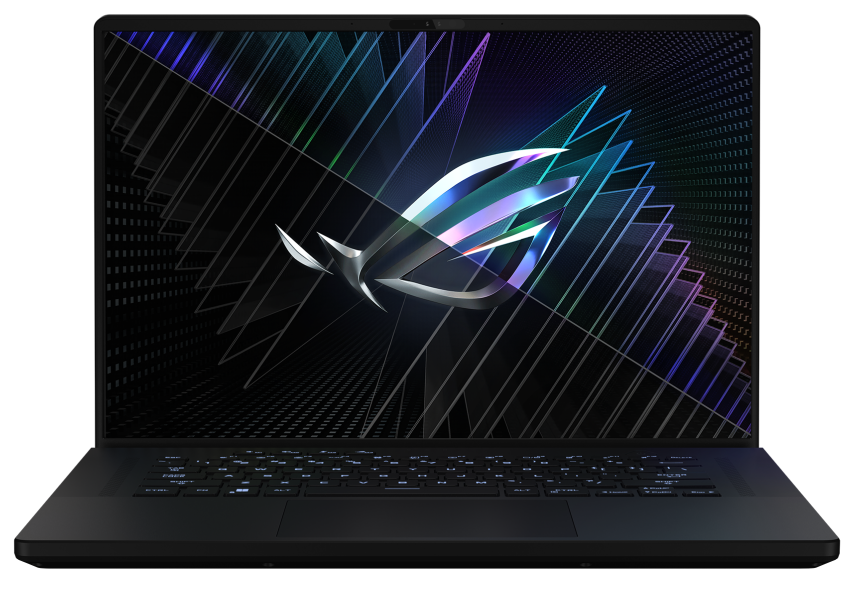I’ve owned computers from both the Mac and Windows camps over the years. I’ve used them from everything to note taking, gaming, content production, development and more.
I’ve never been a big fan of the Windows laptops that I have used – either personally, or when working in the field with them. The ASUS ROG Zephyrus M16, however, is a pretty solid device, and has definitely made me rethink my stance on Windows laptops.
Let’s talk about Specs, Baby!
The most important thing about the laptop – the specs! For the model I reviewed, they’re as follows:

- CPU: Intel 13th Gen Core i9-13900H (2.6GHz, up to 5.4GHz; 6 Performance Cores and 8 Efficiency Cores)
- GPU: NVIDIA GeForce RTX 4070 Laptop GPU with 8GB DDR6 memory
- RAM: 32GB DDR5-4800
- Size: 16” 240hz IPS panel
- Storage: 1TB NVME SSD
- Display: 16” 240hz, 2560×1600 native resolution (16:10 aspect ratio, 1440p WQXGA)
- WiFi-6E (802.11ax), Bluetooth 5.3.
When I first looked at the laptop, I did a quick inspection of the ports that are available on it. Ports are a big deal, and the right combination of ports can make or break a device.
- 1x Thunderbolt 4
- 2x USB 3.2 Gen 2 Type A
- 1x USB 3.2 Gen 2 Type C
- 1x HDMI 2.1
- 1x 3.5mm combination audio jack.
The Thunderbolt port is a very welcome inclusion. Folks who use a Thunderbolt dock will be able to plug their laptop into power, a display and peripherals with a single USB-C cable.
The display outputs are pretty solid, and should allow for a good combination of displays if you wanted to use this laptop as a desktop replacement. There’s enough USB to give you enough to work with on the go, without tons of useless or poorly placed ports. If you were using this as a desktop replacement, you’d want a USB hub for sure.
Fit and Finish
The Zephyrus is a great laptop. It weighs about as much as my MacBook Pro, and has a solid frame. It doesn’t flex at the edges, but there is a bit of give in the top center above the keyboard. That’s not a problem in my mind, as that’s not where the stress will be on the device. The palm rests feel sturdy, and I don’t feel like I’m about to put my arm through the laptop during a game of League of Legends.
The keyboard feels pretty good to play games with and type with. It’s a membrane keyboard (which is pretty common for a laptop). There’s no number pad, but if you really need one you can pick up a USB one or use an external keyboard.
Quite possibly my biggest delight has been the trackpad. On other Windows laptops I’ve used in the past, the trackpad has been a massive disappointment. This trackpad is almost on par with my MacBook Pro. It’s the same size, and responds well to gestures such as two finger scrolling and right click. When I first started using the laptop, I used these gestures without even thinking, and was pleasantly surprised when they worked. Bravo!
Rivalling my trackpad obsession is the display, which is fantastic. It’s bright, and the IPS panel provides good viewing angles all around. The refresh rate provides a buttery smooth experience and colour reproduction is excellent. The bezels are very minimal around the edges, and even the frame at the top where the webcam is placed is pretty minimal.
With the outside of the laptop covered, let’s talk about it’s innermost workings.
A word on testing…
This review is pretty light on benchmarks; and instead focuses more on the more practical elements of using the laptop. While there are folks who love a good benchmarking graph (and I’m one of them!), it takes a lot of time and effort to build up the capability to effectively test and ensure you have accurate and correct data.
“The system handles multi-core workloads quite well. Your games and creation tasks should run nicely on those performance cores.”
CPU Performance
The good news is that, out of the box, the ASUS ROG Zephyrus M16 should be able to power through most (if not all) of your use cases – regardless of what you’re doing.
To stress out the CPU, I ran a Cinebench R23 Multicore test on this machine. While it’s a synthetic benchmark (in that it pushes the machine as hard as humanly possible), it’s a great test of how the system performs under high CPU load.
The i9 13900H put up a respectable score of 13795 – only being beaten out (of the default stats in Cinebench) by Ryzen Threadrippers and Intel Xeons – both CPUs designed for heavy workloads in workstations and servers. It’s a great result for a mobile chipset.
With 20 logical cores (6 performance cores with two threads each, and 8 efficiency cores), the system handles multi-core workloads quite well. It’s not just the sheer volume of cores that really helps out here – but having a number of performance and efficiency cores dedicated to certain tasks.
Your games and creation tasks should run nicely on those performance cores, but your background tasks shouldn’t grind to a halt either, because they’ll be running on the efficiency cores. This will depend on the specific workload you throw at the machine to get the best results.
GPU Performance
The ASUS ROG Zephyrus M16 is sporting a NVIDIA RTX 4070 Laptop GPU. There’s an onboard GPU for less graphically intensive tasks, but we’ll be focusing on the 4070.
The desktop version of NVIDIA’s 40-series has been something of a mixed bag. While the 4090 and 4080 both perform at the top of their classes, they consume a lot of power to do so – which creates more heat; and requires more cooling to keep it cool.
On the lower end cards, however, it’s not so much power and heat (or melting power cables) that dominate the discussion, but the lack of VRAM, or Video RAM. With a lot of games these days offering high resolution assets for higher resolution displays, many mid range graphics cards simply do not have enough memory for the workload that is often requested for them.
Of course, the fix is to turn off functionality like ray tracing, or turn down quality settings. But that’s not really a lot of fun; particularly for the price tag that the Zephyrus commands.
My first stop in testing out the GPU was 2020’s Doom Eternal. When played at the native resolution of 2560×1600, I was able to have the quality settings on Ultra Nightmare (the highest preset) with Ray Tracing and HDR all enabled. Most of my testing showed a pretty consistent 75-85 FPS and the gameplay was quite smooth.

My next test was Cyberpunk 2077 – and here’s where a little more nuance started showing through. Using the default preset of Ray Tracing: Ultra, the RTX 4070 puts out a playable 45 FPS during the built in benchmark. What concerned me was the wild variances of FPS – sometimes as low as 15 FPS, or as high as 100+ FPS. The spikes didn’t intrude too badly on the benchmark quality, although I definitely did notice some hitching as I was testing.
From the games that I tested, it’s fair to say that while the machine can run demanding games at native resolutions with everything cranked up; you’ll need to make sure you balance quality with performance, particularly for newer games. This is doubly true if you’re using an external display with a higher resolution.
Testing games with my 34” Dell Ultrawide (3440×1440) caused performance to take a hit. It was improved by disabling ray tracing, and bringing the quality down to a more medium level preset. If you’re planning on using an external monitor that is of a higher resolution than the internal monitor, you will need to keep an eye on your settings to ensure the best balance between quality and performance, favouring what’s more important to you.
Fan goes “brrrrr!”
It’s definitely worth talking about fan profiles and performance with any sort of laptop, particularly a gaming laptop. Out of the box, you can use the Armoury Crate application to swap between a performance, turbo or silent fan profile.
The fan profiles are responsive to swap between, which is great. Just as importantly, the fans are quick to adjust to the selected profile.
However, when the system is under load, the fans are loud! If you’re using headphones, then it’s probably fine – but I wouldn’t want to be on Discord with the laptop fans at full power.

So, who is this laptop for, anyways?
ASUS has it’s sights squarely set on the gaming and creative spaces with this laptop. They’re targeting gamers, game developers, and content creators. That’s a pretty wide swathe of usages, and more importantly, different ways that the laptop will need to perform to succeed in those use cases.
If you’re interested in more creation style work, the ASUS ROG Zephyrus M16 should serve you pretty well. Gaming, however, will depend on what your game preferences are like, and how you feel about adjusting quality settings.
For the folks who are OK with playing older games or are OK with tweaking games to get better performance, this laptop will suit nicely.
ASUS kindly provided Checkpoint Gaming with a loan laptop for this review.





